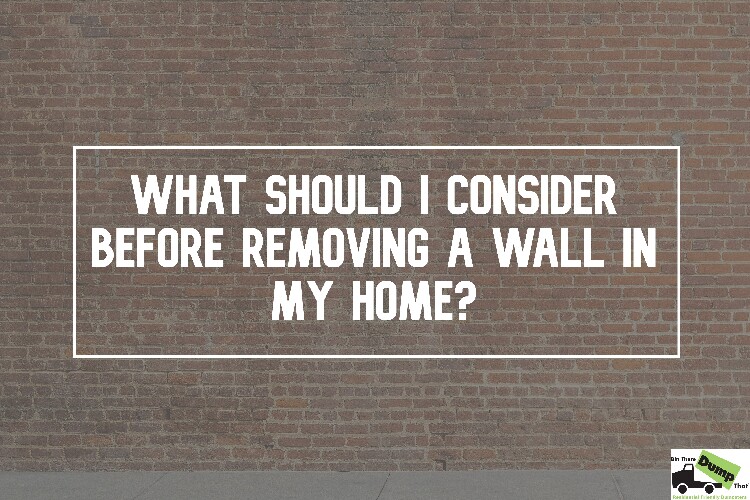
If you’re like me, it’s easy to get lost in all of those home renovation shows on HGTV and DIY Network. The kitchens are sleek and modern; the budgets are ridiculous; wall demolition looks unbelievably therapeutic; and the open floor plans are something on everyone’s must-have list.
And while everyone doesn’t have the budget for an entirely new kitchen, it’s a safe bet there’s at least one wall standing in the way of you and that spacious, open floor plan you’ve always wanted. One interior wall that almost always gets the ax is the dividing wall between the kitchen and the dining room or family room. Another renovation trend is to remove the dividing wall between your bathroom and master bedroom.
By removing a wall, you’re creating an entirely new and flexible living space in your home, something most new home buyers are seeking these days.
But before you dust off your sledgehammer and schedule your dumpster rental, there are a few things you’re definitely going to want to consider before removing a wall inside your home.
A load-bearing wall is one that actually helps support and hold up your home. Removing a structurally important

If it’s absolutely necessary for a load-bearing wall to be altered or removed, consider your options, like incorporating support columns or instead of removing the wall completely, simply add a doorway or widen existing one.
Since we started out talking about load-bearing walls, it’s important to know that a project like that will require you to make trip to your city’s building department for a building permit — you may also be required to submit plans of the changes you’re interested in making to your home.
Regardless of whether the wall is load bearing, a call into your insurance provider is also a smart move for two reasons. One, it’s good to know you’re covered just in case there’s an accident while you’re hard at work. Also, since you’re in the process of reconfiguring the layout of your home, adding or removing a room may affect your coverage or how your coverage is structured.
A box of old letters, mouse traps, gold bars — if home renovation enthusiasts know one thing, it’s that there’s always something lurking behind or between old walls. In most cases, though, wires, HVAC ducts and pipes are what you’ll find.
If this is true, you’ll need hire a qualified electrician or plumber (or both) to reroute or cap off the utilities in question. And do this before you start poking into the wall. Running into gas lines or live wires unexpectedly can be dangerous and even life threatening.
If your home was built before the 1970s, there’s a good chance it has one of the following: lead paint, asbestos and mold. When the walls start coming down, dust and debris from hazardous materials will start flying. Make sure your workspace is properly ventilated.
Heavy duty work gloves, protective eyewear and a safety respirator should also be a part of your renovation wardrobe.
YES!
Removing a wall in your home will dramatically change the look and feel of your living space. Before you start
applying the elbow grease, ask yourself a few questions (and check out Bin There Dump That's Guide To Home Renovation on the right):The last thing you want to do is second guess yourself AFTER you started the demolition. And a job gone wrong can end up costing you more than it would to hire a professional from the start. Check out consumer review sites like Angie’s List and Yelp! to find a trusted contractor in your area.
They will be able to clue you in on the type of project you’re about to undertake and if hiring a professional to do the work makes the most sense.
Always keep in mind that we are trying to save the environment by disposing of waste properly but there are certain parts of a home that can be recycled and maybe even re-purposed around the house. If nothing is salvageable, then you're probably better off recycling it or hiring a company that does it all for you and that's where the next part comes in.
Taking down a wall (non load bearing) can be simple, smart AND stress relieving. No matter what home renovation project you plan — removing a wall or three — or whether you hire a professional or tackle it yourself, you’re likely to produce a fair amount of scrap.
Order a Bin There Dump That rental dumpster bin to deposit the drywall, wood, bricks, bent nails and shattered glass (and egos), cement, plastic, paper, metal, ceramic, PVC piping, and the list goes on.
The next time your home renovation ideas turn into a project, find the nearest franchise operator and get your dumpster rental delivered in time.
Friendly, professional customer service, plus fair pricing, equals value.